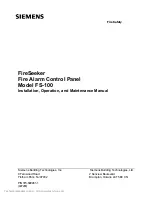
DEVELOP AND PRACTICE A PLAN OF ESCAPE
BASICS OF ESCAPE PLAN
o Make a floor plan indicating all doors and windows and at least two escape routes from each
room. Second story windows may need a rope or chain ladder.
o Have a family meeting and discuss your escape plan, showing everyone what to do in case of fire.
o Determine a place outside your home where all of you can meet if a fire occurs.
o Familiarize everyone with the sound of the smoke alarm and train them to leave your home when
they hear the sound.
o Identify children's bedrooms with red stickers placed in the upper left corner of the windows. They
are available from your local fire department.
o Practice a fire drill at least every six months. Practice allows you to test your plan before an
emergency. You may not be able to reach your children. It is important they know what to do!
WHAT TO DO WHEN THE ALARM SOUNDS
o Leave immediately by your plan of escape. Every second counts, so don't waste time getting
dressed or picking up valuables.
o In leaving, don't open any inside door without first feeling its surface. If hot, or if you see smoke
seeping through cracks,
don't open that door!
Instead, use your alternate exit. If inside door is
cool, place your shoulder against it, open it slightly and be ready to slam it shut if heat and smoke
rush in.
o Stay close to the floor if air is smoky. Breathe shallowly through a cloth, wet if possible.
o Once outside, go to your selected meeting place and make sure everyone is there.
o Call the fire department from your neighbor's home –
not from yours!
o Don't return to your home until fire officials say that it is all right to do so.
Page 8
NATIONAL FIRE PROTECTION ASSOCIATION REQUIRED INFORMATION
For your information, the National Fire Alarm Code, NFPA 72, reads as follows:
"11.5.1 *Required Detection - Where required by applicable laws, codes, or standards for a specific
type of occupancy, approved single and multiple-station smoke alarms shall be installed as follows:
(1) *In all sleeping rooms and guest rooms
(2) *Outside of each separate dwelling unit sleeping area, within 6.4 m (21 ft) of any door to a
sleeping room, the distance measured along a path of travel
(3) On every level of a dwelling unit, including basements.
(4) On every level of a residential board and care occupancy (small facility), including basements
and excluding crawl spaces and unfinished attics
(5) *In the living area(s) of a guest suite
(6) In the living area(s) of a residential board and care occupancy"
The equipment should be installed using wiring methods in accordance with the
National Fire Protection Association's Standard 72.
(National Fire Protection Association, Batterymarch Park, Quincy, MA 02269)
BACKUP BATTERY REPLACEMENT
Disconnect AC power before changing battery. Shock hazard exists if AC power is miswired.
This smoke alarm uses a 9 Volt battery. The battery should last for at least one year under normal
operating conditions. The smoke alarm has a low battery indicator, an audible beep or chirp. It will
operate at approx. 40 second intervals for a minimum of 7 days. When this indication occurs, replace
the battery with a Carbon Zinc type battery GP1604S, an Alkaline type Energizer #522 or Lithium
type Energizer LA522, Ultralife U9VL-J or Ultralife U9VL-J-P from your local retailer.
Lithium Battery Models only - The Lithium battery is warranted to last for 10 years* under normal
operating conditions. Replace the battery with only Lithium type Energizer LA522 or Ultralife U9VL-
J or U9VL-J-P.
*DISCLAIMER: WARRANTY IS NOT A PERFORMANCE CLAIM.
OPTIONAL BATTERY DRAWER TAMPER LOCKING PIN: To make your battery drawer tamper
resistant, a locking pin has been provided (breakaway part on mounting bracket).
NOTE: If this feature has been activated, you will need to deactivate it by removing the battery
drawer tamper pin located at side of battery drawer. Refer to Page 5.
Pull the QUICK DRAW
(R)
battery drawer open and remove the battery. While observing polarity,
push the replacement battery into the battery drawer until it is held securely in place. Carefully close
the battery drawer and reinstall the tamper pin.
Test the smoke alarm by pushing the TEST button on the smoke alarm cover until the alarm sounds,
then release.
REPAIRS AND SERVICES
If the smoke alarm is defective in any way, do not tamper with the smoke alarm. Return the smoke
alarm for servicing. (See warranty for instructions or in-warranty returns.) There will be a service
charge for repairing out of warranty smoke alarms.



















